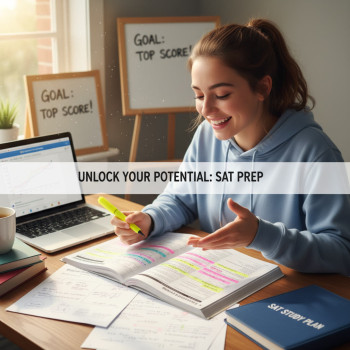When Two Homes Meet One Goal: Supporting SAT Prep through Divorce or Separation
College admissions is a family project, but when parents are divorced or separated, the logistics and emotions can feel extra complicated. If you’re a student, a parent, or both, this guide is written to be realistic, gentle, and actionable—because your child’s SAT journey should never be another battlefield. It can be a place where curiosity, teamwork, and clear planning win the day.

Why this matters now—especially for the Digital SAT
The SAT shifted to a digital format in recent years, which changed timing, question delivery, and test-day technology needs. That means new prep habits—shorter adaptive sections, practice on devices, and more strategic use of time—are important. All of this is straightforward to navigate when families coordinate, but it requires clear communication and a shared plan. When parents are separated, students can still benefit from consistent routines, aligned expectations, and emotional support at both homes.
What students need most (regardless of household situation)
- Predictable practice schedules—short, focused sessions that add up.
- Access to device-based practice so the Digital SAT format feels familiar.
- Emotional steadiness: encouragement, not pressure.
- Clear logistics for registration, deadlines, and test-day plans.
- Personalized instruction when gaps need targeted attention.
Start with a Student-First Conversation
Before calendars and budgets, ask: what does the student want and need? An honest, student-centered conversation reduces tug-of-war dynamics and creates a shared purpose.
Suggested questions to guide the talk
- What are your target schools and their testing policies?
- How comfortable are you with timed digital practice?
- Which section feels the hardest—Reading & Writing or Math?
- How much time do you want to spend each week on SAT study?
- What kind of support do you want from each parent?
Record answers and share them with both parents—this keeps the student’s voice at the center.
Practical Steps for Co-Parenting SAT Prep
Coordinating two households doesn’t mean doing everything together. It means aligning on essentials so the student gets steady support regardless of location.
1. Decide who handles which tasks
Break responsibilities into clear roles so small things don’t become big fights.
- Registration & paperwork: decide who registers the student for the test and who maintains the College Board account.
- Materials & tech: agree on who provides a reliable device for practice and test-day use (if needed).
- Scheduling: align on which test date(s) are realistic—include back-up dates in case of illness or conflicts.
- Transportation: decide who will provide rides or cover travel costs for test day.
2. Share a single calendar
Use a shared digital calendar (or a printed one if that’s easier) to mark practice times, mock tests, registration deadlines, and test day. When everyone can see important dates, last-minute surprises disappear.
3. Budget transparently
Cost questions—tutoring, practice tests, test fees—are common stressors. A simple budget plan outlining who pays what (and when) prevents misunderstandings. Consider splitting fixed costs, or designating one parent to cover tutoring while the other covers test-day expenses, depending on financial realities.
Creating a Smart, Flexible Study Plan
Effective study plans treat the Digital SAT like a skill—practice, feedback, correction, and repetition. The good news: the plan doesn’t have to be complicated.
Elements of a balanced SAT study plan
- Baseline diagnostic: a full-length digital practice test to identify strengths and weaknesses.
- Weekly rhythm: 3–6 practice sessions per week, mixing timed sections and targeted review.
- Monthly full-length practice: simulate test day to build stamina and comfort with the adaptive digital format.
- Targeted drills: short exercises for specific weak spots, like vocabulary-in-context or algebra fluency.
- Reflection & adjustment: review missed questions and adjust study focus every two weeks.
Example 12-week plan (adaptable)
| Week | Focus | Weekly Activities |
|---|---|---|
| 1 | Diagnostic & baseline | One full digital practice test, initial goal-setting, schedule created |
| 2–4 | Foundations & strategy | 3 short sessions + 1 section-timed practice; review strategies for calculator/non-calculator math |
| 5–8 | Targeted skill building | 2 targeted drills + 2 full section practices; one full-length practice per month |
| 9–10 | Simulated test cycles | Every other week: full-length digital practice with full review |
| 11–12 | Polish & logistics | Fine-tune pacing, finalize test-day logistics and travel, light practice and confidence-building |
Navigating Communication Challenges
It’s normal for co-parenting communication to be awkward. The key: keep conversations practical, brief, and focused on the student’s needs.
Communication habits that help
- Use shared documents (Google Doc, shared note) for schedules and test info—no need to rehash details in multiple texts.
- When conflict arises, return to the student’s plan. Ask: Will this decision help the student reach their goals?
- Limit emotional conversations around the child—save those for private moments or mediated discussions.
- Agree on messaging to the student. Avoid passing conflicting instructions or pressure.
Emotional Support: The Invisible Test Prep
Preparation isn’t just content and calendars. Students perform best when they feel secure, not split between pressures at different homes.
Ways parents can provide emotional steadiness
- Celebrate small wins—improved practice scores, consistent study habits, or progress on timing.
- Keep pressure proportional; remind students a single test is not their whole story.
- Offer predictable downtime: a consistent quiet hour for study and one afternoon each week where the student is free to rest.
- Normalize help-seeking: tutoring, school counselors, and test coaches are tools—never a sign of failure.
How to Choose and Use Tutoring Wisely (including personalized help)
Tutoring can accelerate progress, especially when it’s targeted and personalized. For families managing two households, a tutor who coordinates with both parents and respects logistics is invaluable.
Questions to ask when selecting a tutor
- Do they have experience with the Digital SAT format?
- Will they create a tailored plan based on a diagnostic, not just a generic curriculum?
- Can they share progress reports with both parents if requested?
- Do they offer flexible scheduling that works with two households?
Personalized services, like Sparkl’s personalized tutoring, can be particularly helpful: 1-on-1 guidance, tailored study plans, expert tutors, and AI-driven insights make it easier to focus on the student’s unique gaps and strengths while keeping communication streamlined across households. If a family chooses a program like this, ask about trial sessions and how the tutor will update both homes.
Logistics for Test Day: Keep It Simple and Redundant
Test day is stressful by default. With divorced or separated parents, redundancy and clarity are your superpowers.
Test-day checklist
- Confirm registration and test center details at least two weeks before the test.
- Decide who will be the primary contact on test day and share that info with both households.
- Pack essentials the night before: admission ticket, ID, charger for device if the testing center allows one, snacks, water, and layered clothing.
- Plan transportation back-ups in case of delays—ride-share, another parent, or a trusted adult list.
What to do if conflicts arise (schedule, travel, or finances)
- Prioritize the student’s timeline—reschedule to the nearest reasonable test date if necessary.
- If finances are the issue, look into fee waivers or split costs across parents. Many schools and community organizations can provide guidance on fee waivers for tests and college applications.
- When all else fails, involve a neutral third party—school counselor or college advisor—to help coordinate.
Special Situations and Practical Solutions
When a parent travels or is frequently unavailable
Create a clear single-point contact for test-day logistics—someone local who can step in. Keep digital copies of registration info, and add the traveling parent to the shared calendar so they stay informed.
When custody schedules interrupt consistent study time
Flexibility is key. Build study blocks into both households’ routines so there’s always a dependable slot the student can count on. Even 30 focused minutes most days beats two marathon sessions once a week.
When parents disagree about how much to push
Defer to the student’s goals and the diagnostic evidence. If one parent wants intense prep and the other prefers a lighter approach, use data (practice scores, tutor recommendations) to build compromise: for example, a moderate weekly plan with an optional extra session paid for by the parent who wants more intensity.
Tools and Resources That Make Life Easier
Digital resources make the Digital SAT less mysterious. Use device-based practice to replicate test conditions, review analytics to spot patterns, and use structured tutoring to focus improvements.
Recommended resource checklist
- Official College Board practice tests and question sets (digital practice where possible).
- Timed digital practice sessions to build tech comfort.
- A diagnostic dashboard to track improvement—weekly snapshots help guide parent conversations.
- A tutor or program that offers short progress reports both parents can access, if agreed upon.
Stories of Real Families (short examples you can learn from)
Example 1 — Coordinated roles: Maya’s parents split costs and responsibilities: Dad handled registration and test day transportation, Mom arranged evening practice blocks and paid for a weekly tutor. Maya knew who to ask for what, and both parents received a monthly report from the tutor, keeping tensions low and support high.
Example 2 — One parent travels: Julian’s mom traveled frequently. They set up a shared drive with all test materials and a rotating study schedule that his dad followed. Julian used a personalized tutoring program with flexible hours to fit both homes’ schedules. Clear documentation of the plan kept everyone aligned.
When to Seek Professional or School-Based Help
If communication breaks down or financial questions feel impossible to resolve alone, school counselors are trained to help with logistics and can often mediate. For intensive academic needs, a tutor or a structured program can provide individualized instruction and relieve parents from trying to play coach.
Signs it’s time for extra help
- Practice scores plateau despite consistent study.
- Student shows anxiety that interferes with sleep or daily functioning.
- Scheduling conflicts repeatedly cause missed practice or tests.
- Parents cannot agree on basic logistics after reasonable attempts to coordinate.
Final Checklist: A Practical Roadmap for Families
| Item | Who does it | When |
|---|---|---|
| Baseline digital diagnostic | Student + parent arranging time | Week 1 |
| Shared calendar with practice & test dates | Both parents | Immediately after diagnostic |
| Assign task roles (registration, transportation, payments) | Both parents | Within first two weeks |
| Decide on tutoring or help | Parents + student | Weeks 2–4 |
| Test-day logistics finalized | Primary contact | 2 weeks before test |
Words for Students: You’re Not Carrying This Alone
If you’re the student in the middle of two homes, know this: your goals are valid, your voice matters, and your feelings are real. You don’t need to choose between parents’ preferences—choose what helps you learn and grow. Ask for clarity. Ask for routines. Ask for kindness.
Words for Parents: Lead with the Student’s Best Interest
When the emotional past pushes up, remember the future you want for your child. Clear roles, shared calendars, transparent budgets, and measured expectations create a calm environment where learning happens. If you can come together around these practical steps—even when you can’t co-parent everything—you’ll give your student a major advantage.
Where Personalized Programs Fit In
Programs that provide one-on-one guidance, tailored study plans, and data-driven insights can smooth tensions between households because they create an objective baseline: the student’s progress. If both parents agree, consider a trial period with a personalized tutoring service that offers flexible scheduling and clear reporting. That outside structure often reduces negotiation and focuses everyone on measurable progress.
Closing Thoughts: A Test, Not a Trial
The Digital SAT is a milestone—but it is not the measure of a young person’s worth. With empathy, small routines, and practical coordination between homes, students can prepare effectively and with less stress. This is a chance for parents to model cooperation and problem-solving—and to show that, even when life shifts, a student’s future stays steady.

If you’d like, I can help you draft a one-page study agreement template, a shared calendar layout, or a series of short messages to send between parents to reduce friction. Small tools like these make a big difference.















No Comments
Leave a comment Cancel